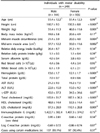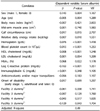1. International Neuromodulation Society (US). Motor impairment [Internet]. San Francisco (CA): International Neuromodulation Society;2012. updated 2014 Jan 29. cited 2016 May 10. Available from:
http://www.neuromodulation.com/motor-impairment.
2. Karagiozoglou-Lampoudi T, Daskalou E, Vargiami E, Zafeiriou D. Identification of feeding risk factors for impaired nutrition status in paediatric patients with cerebral palsy. Acta Paediatr. 2012; 101:649–654.

3. Rogers B. Feeding method and health outcomes of children with cerebral palsy. J Pediatr. 2004; 145:S28–S32.

4. Reilly S, Skuse D. Characteristics and management of feeding problems of young children with cerebral palsy. Dev Med Child Neurol. 1992; 34:379–388.

5. Sullivan PB, Juszczak E, Lambert BR, Rose M, Ford-Adams ME, Johnson A. Impact of feeding problems on nutritional intake and growth: Oxford Feeding Study II. Dev Med Child Neurol. 2002; 44:461–467.

6. Sura L, Madhavan A, Carnaby G, Crary MA. Dysphagia in the elderly: management and nutritional considerations. Clin Interv Aging. 2012; 7:287–298.
7. Rowat A. Malnutrition and dehydration after stroke. Nurs Stand. 2011; 26:42–46.

8. Corrigan ML, Escuro AA, Celestin J, Kirby DF. Nutrition in the stroke patient. Nutr Clin Pract. 2011; 26:242–252.

9. Day SM, Strauss DJ, Vachon PJ, Rosenbloom L, Shavelle RM, Wu YW. Growth patterns in a population of children and adolescents with cerebral palsy. Dev Med Child Neurol. 2007; 49:167–171.

10. Smith BJ, Bachrach SJ. An unexpected finding in an eight-year-old child with cerebral palsy and weight loss. J Natl Med Assoc. 2006; 98:280–283.
11. Jönsson AC, Lindgren I, Norrving B, Lindgren A. Weight loss after stroke: a population-based study from the Lund Stroke Register. Stroke. 2008; 39:918–923.
12. Patterson CH. Questions & answers from the JCAHO. What new standards are in store for 2000? Nurs Manage. 1999; 30:9.
13. Wallace JI, Schwartz RS, LaCroix AZ, Uhlmann RF, Pearlman RA. Involuntary weight loss in older outpatients: incidence and clinical significance. J Am Geriatr Soc. 1995; 43:329–337.

14. Bernardi M, Ricci CS, Zaccherini G. Role of human albumin in the management of complications of liver cirrhosis. J Clin Exp Hepatol. 2014; 4:302–311.

15. Barron ME, Wilkes MM, Navickis RJ. A systematic review of the comparative safety of colloids. Arch Surg. 2004; 139:552–563.

16. Naber TH, de Bree A, Schermer TR, Bakkeren J, Bär B, de Wild G, Katan MB. Specificity of indexes of malnutrition when applied to apparently healthy people: the effect of age. Am J Clin Nutr. 1997; 65:1721–1725.

17. Friedman AN, Fadem SZ. Reassessment of albumin as a nutritional marker in kidney disease. J Am Soc Nephrol. 2010; 21:223–230.

18. Herrmann FR, Safran C, Levkoff SE, Minaker KL. Serum albumin level on admission as a predictor of death, length of stay, and readmission. Arch Intern Med. 1992; 152:125–130.

19. Eljaiek R, Dubois MJ. Hypoalbuminemia in the first 24h of admission is associated with organ dysfunction in burned patients. Burns. 2013; 39:113–118.

20. Wu AW, Yasui Y, Alzola C, Galanos AN, Tsevat J, Phillips RS, Connors AF Jr, Teno JM, Wenger NS, Lynn J. Predicting functional status outcomes in hospitalized patients aged 80 years and older. J Am Geriatr Soc. 2000; 48:S6–S15.

21. Jensen GL, Kita K, Fish J, Heydt D, Frey C. Nutrition risk screening characteristics of rural older persons: relation to functional limitations and health care charges. Am J Clin Nutr. 1997; 66:819–828.

22. Zuliani G, Romagnoni F, Volpato S, Soattin L, Leoci V, Bollini MC, Buttarello M, Lotto D, Fellin R. Nutritional parameters, body composition, and progression of disability in older disabled residents living in nursing homes. J Gerontol A Biol Sci Med Sci. 2001; 56:M212–M216.

23. Ohwada H, Nakayama T. The distributions and correlates of serum albumin levels in institutionalised individuals with intellectual and/or motor disabilities. Br J Nutr. 2008; 100:1291–1296.

24. Hisamichi S. Community screening programs of cancer and cardiovascular diseases in Japan. J Epidemiol. 1996; 6:S159–S163.

25. Lohman TG, Roche AF, Martorell R. Anthropometric Standardization Reference Manual. Champaign (IL): Human Kinetics Books;1988.
26. Thangawng AL, Kim JS, Golden JP, Anderson GP, Robertson KL, Low V, Ligler FS. A hard microflow cytometer using groove-generated sheath flow for multiplexed bead and cell assays. Anal Bioanal Chem. 2010; 398:1871–1881.

27. Malkiel S, Jeganathan V, Wolfson S, Manjarrez Orduño N, Marasco E, Aranow C, Mackay M, Gregersen PK, Diamond B. Checkpoints for autoreactive B cells in the peripheral blood of lupus patients assessed by flow cytometry. Arthritis Rheumatol. 2016; 68:2210–2220.

28. Jung HJ, Ahn HI, Park JY, Ho MJ, Lee DR, Cho HR, Park JS, Choi YS, Kang MJ. Improved oral absorption of tacrolimus by a solid dispersion with hypromellose and sodium lauryl sulfate. Int J Biol Macromol. 2016; 83:282–287.

29. Xu L, Meng MQ, Liu R, Wang K. Robust peak detection of pulse waveform using height ratio. Conf Proc IEEE Eng Med Biol Soc. 2008; 2008:3856–3859.
30. Schiavone NM, Sarver SA, Sun L, Wojcik R, Dovichi NJ. High speed capillary zone electrophoresis-mass spectrometry via an electrokinetically pumped sheath flow interface for rapid analysis of amino acids and a protein digest. J Chromatogr B Analyt Technol Biomed Life Sci. 2015; 991:53–58.

31. Loh TP, Leong SM, Sethi SK. High concentration of IgM-κ paraprotein causes over-estimation of serum total protein by certain biuret method. Clin Chem Lab Med. 2013; 51:e205–e207.

32. Xu Y, Wang L, Wang J, Liang H, Jiang X. Serum globulins contribute to the discrepancies observed between the bromocresol green and bromocresol purple assays of serum albumin concentration. Br J Biomed Sci. 2011; 68:120–125.

33. Eto A, Shiki A, Chikaura Y, Oka T, Nakano NI. Multienzyme control serum (Seraclear-HE) containing human enzymes from established cell lines and other sources. 1: preparation and properties. Clin Chem. 1995; 41:872–880.

34. Music M, Dervisevic A, Pepic E, Lepara O, Fajkic A, Ascic-Buturovic B, Tuna E. Metabolic syndrome and serum liver enzymes level at patients with type 2 diabetes mellitus. Med Arch. 2015; 69:251–255.

35. Can M, Acikgoz S, Mungan G, Ugurbas E, Ankarali H, Sumbuloglu V, Demirtas S, Karaca L. Is direct method of low density lipoprotein cholesterol measurement appropriate for targeting lipid lowering therapy? Int J Cardiol. 2010; 142:105–107.

36. Makino M, Hayashi Y, Ito H, Morikawa A. Principal component analysis for microalbuminuria in patients with noninsulin-dependent, maturity-onset diabetes mellitus. Rinsho Byori. 1990; 38:65–70.
37. Roh EJ, Lim JW, Ko KO, Cheon EJ. A useful predictor of early atherosclerosis in obese children: serum high-sensitivity C-reactive protein. J Korean Med Sci. 2007; 22:192–197.

38. Alley ML, Haines DM, Smith GW. Short communication: evaluation of serum immunoglobulin G concentrations using an automated turbidimetric immunoassay in dairy calves. J Dairy Sci. 2012; 95:4596–4599.

39. Sugiyama M. The revolution of nutritional care and management in the revised long-term care insurance. J Natl Inst Public Health. 2006; 55:32–41.
40. Current State of the National Health and Nutrition: The National Health and Nutrition Survey in Japan 2008. Tokyo: Dai-ichi Shuppan Co.;2011.
41. Sokoll LJ, Dawson-Hughes B. Effect of menopause and aging on serum total and ionized calcium and protein concentrations. Calcif Tissue Int. 1989; 44:181–185.

42. Ridker PM, Glynn RJ, Hennekens CH. C-reactive protein adds to the predictive value of total and HDL cholesterol in determining risk of first myocardial infarction. Circulation. 1998; 97:2007–2011.

43. Ikizler TA, Wingard RL, Harvell J, Shyr Y, Hakim RM. Association of morbidity with markers of nutrition and inflammation in chronic hemodialysis patients: a prospective study. Kidney Int. 1999; 55:1945–1951.

44. Nakamura K, Moriyama Y, Kariyazono H, Hamada N, Toyohira H, Taira A, Yamada K. Influence of preoperative nutritional state on inflammatory response after surgery. Nutrition. 1999; 15:834–841.

45. Fein PA, Mittman N, Gadh R, Chattopadhyay J, Blaustein D, Mushnick R, Avram MM. Malnutrition and inflammation in peritoneal dialysis patients. Kidney Int Suppl. 2003; S87–S91.

46. Danielski M, Ikizler TA, McMonagle E, Kane JC, Pupim L, Morrow J, Himmelfarb J. Linkage of hypoalbuminemia, inflammation, and oxidative stress in patients receiving maintenance hemodialysis therapy. Am J Kidney Dis. 2003; 42:286–294.

47. Fernández-Reyes MJ, Alvarez-Ude F, Sánchez R, Mon C, Iglesias P, Díez JJ, Vázquez A. Inflammation and malnutrition as predictors of mortality in patients on hemodialysis. J Nephrol. 2002; 15:136–143.
48. Kaysen GA, Greene T, Daugirdas JT, Kimmel PL, Schulman GW, Toto RD, Levin NW, Yan G. HEMO Study Group. Longitudinal and cross-sectional effects of C-reactive protein, equilibrated normalized protein catabolic rate, and serum bicarbonate on creatinine and albumin levels in dialysis patients. Am J Kidney Dis. 2003; 42:1200–1211.

49. Haupt W, Holzheimer RG, Riese J, Klein P, Hohenberger W. Association of low preoperative serum albumin concentrations and the acute phase response. Eur J Surg. 1999; 165:307–313.








 PDF
PDF ePub
ePub Citation
Citation Print
Print



 XML Download
XML Download